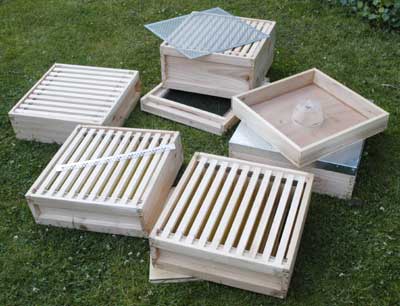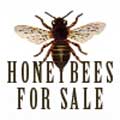Norfolk Honey - Norfolk Mongrels

Norfolk Mongrels
I often get asked what type of bees we sell when selling nucs.
Honeybees have probably been in UK for thousands of years as they almost certainly
moved in as the ice retreated after the last ice age. I don't know how long
they have been kept by 'bee keepers' but colonies of bees were
left in wills hundreds of years ago. (Will
of Stephen Lacelett of Woodnesboro
- 21 February 1703 includes a small cask of mead and 10 beehives)
Today the relationship between honeybees and their beekeepers is a critical
one as without the beekeeper is it possible that no honey bees would survive
in the UK at all now. The introduction (in error by beekeepers) of the Varroa
mite has radically changed beekeeping in the last twenty years. So far there
isn't
a bee keeper in the UK who can keep bees consistently from year to year without
treating them for mites.
Possibly if all treatment stopped tomorrow some bees somewhere would survive. Maybe there is enough resistance in an apiary or two, or even more. Who knows. What we do know is that all of those beekeepers who who didn't treat for mites and thought their bees would cope on their own when the mite first arrived lost their bees.
Now we treat the colonies with a variety of substances and
use several mechanical processes to remove the mites. Possibly we are inadvertently
selecting the bees that can best cope with the chemicals we use to remove
the mites. Certainly if they don't survive both the mites and the treatments
then we can't breed from them
The stock of bees kept by bee keepers in the UK has for years been supplemented
by bees bought in from outside. Today you can not only buy bees from
the continent but also from the other side of the world (New Zealand). Bee
keepers seem to have been on the hunt for better bees for generations.
The most famous UK beekeeper to go into bee breeding in the most detail must be the late Brother Adam who searched for bees in many countries to add to his breeding colonies. Eventually Brother Adam developed his own strain of 'Buckfast' bees using isolated apiaries on the moors in Devon. There are many bees in the UK today that can be best described as Buckfast in origin.
Bees are imported from Italy, Greece and many other European countries for a variety of reasons. 'Italians' are popular for making honey. 'Carniolan' bees are imported from Slovenia again for their own special properties. Originally our UK stock of bees (Apis Mellifera Mellifera) were black and larger than most other bees. Some say they no longer exist and other are dedicated to preserving them. So who knows exactly what the story is with our 'Black Bees'?.
Whatever the female line of the bees originally, once they have mated in the wild with unknown males, their offspring are not pure examples of the breed and can only be described as mongrels. Once they have been kept for generation after generation all mated in the wild the beekeeper will have had some influence on how his bees are if he has been selecting to breed from the best. But they are still mongrels. If he is selecting the queens he breeds from only for the amount of honey they make and doesn't take into account how gentle they are when handled then he could end up with some productive yet angry bees.
Most bee keepers don't want 'angry bees' no matter how well they make honey and many an angry queen has ended its time between finger and thumb. I have collected dozens of swarms over the year's and rarely have I picked up really angry bees.
Beekeepers want bees that are easy to work with. Bees that are hardy enough to survive our winters. Bees that do make honey and are not too inclined to swarm. And now we want bees that can survive with mites in the hive. Or better still, bees that will remove mites from each other (grooming bees) and from their hives (hygienic bees).
Is there any difference between Norfolk Mongrels and mongrels from anywhere else in the UK? Probably not much. Once all of the imports and old surviving strains have been mixed together throughout the UK the results are probably pretty similar.
The bees of thousands of bee keepers all being mixed together and mated in the wild just makes a lot of mongrel bees. Mongrel bees that are not exactly the same but possibly not very dissimilar to one another. Of course the more isolated the apiary and consistant the beekeeper then the more uniform his mongrels are likely to be.
Some bee keepers propose that the only way for beekeepers to prosper is to have pure bred new queens for every colony every year. Maybe if you are beekeeping to produce the maximum amount of honey for the lowest possible cost then that is the correct way to proceed. They say that queens mated in the wild are inferior queens that are less productive. They say that the first cross from a highly bred queen may be very good but further crosses are going to be bad and angry. They may be right but introducing new queens to established colonies is not a straightforward process for the beginner to get the hang of.
Many of us, don't need maximum honey yield and our bees have been crossed so many times they are no longer angry. And anyway we want to breed our own queens. We don't have isolated apiary locations as Brother Adam did, so we can't control the available drones for our queens to mate with. Nor do we have the skill or equipment for artificial insemination. So wild mating and mongrel bees it is. Whatever the pedigree of our stock originally all of the bees that have been mated in our Norfolk apiaries can now best be described as 'Norfolk Mongrels'.

